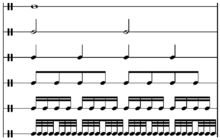Whole note
A whole note (American) or semibreve (international) is a kind of note used in music notation. It has a time duration of four beats in 4
4 time.


| Drum pattern, accompanied by ride patterns of various duple lengths from | |||
Description
The whole note or semibreve has a note head in the shape of a hollow oval—like a half note (or minim)—but with no note stem (see Figure 1). Since it is equal to four beats in 4
4 time, it occupies the entire length of a measure in that time signature.
Other notes are multiples or fractions of the whole note. For example, a double whole note (or breve) lasts twice the duration of the whole note, a half note lasts one half the duration, and a quarter note (or crotchets) lasts one quarter the duration.
A related symbol is the whole rest (or semibreve rest). It usually applies for an entire measure, but may occasionally signify a rest for the duration of a whole note in longer time signatures such as 3
2 or 5
4. (An entire measure rest is drawn centered within the measure, whereas a rest lasting for a whole note is aligned to where the note would be.) Whole rests are drawn as filled-in rectangles generally hanging under the second line from the top of a musical staff, though they may occasionally be put under a different line (or ledger line) in more complicated polyphonic passages, or when two instruments or vocalists are written on one staff and one is temporarily silent.
The whole note and whole rest may also be used to denote a whole measure in music of free rhythm, such as Anglican chant, irrespective of the time of the measure. This usage can be applied generally to any form of music.
History
The whole note symbol is first found in music notation from the late thirteenth century (Morehen and Rastall 2001). It derives from the round, stemless semibrevis of mensural notation, hence the origin of the British name.
Nomenclature
The British term is taken from Italian semibreve, itself built upon Latin -semi "half" and brevis "short." The American whole note is a calque of the German ganze Note. Some languages derive the name of the note from its round shape, such as Catalan rodona, French ronde, and Spanish redonda. The Greek name means "whole". The Chinese, Japanese, Korean, and Vietnamese names mean "whole note".
See also
References
- Morehen, John, and Richard Rastall. 2001. "Semibreve". The New Grove Dictionary of Music and Musicians, second edition, edited by Stanley Sadie and John Tyrrell. London: Macmillan Publishers.